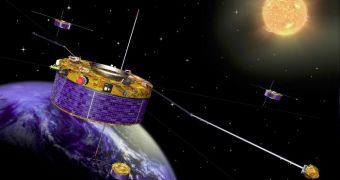Experts at the European Space Agency (ESA) recently detailed a new method of producing killer electrons, deadly variants of the common, more “peaceful” type. Based on data collected by the ESA Cluster satellites, the new study seems to suggest that shock waves sent through the solar system by solar storms are directly responsible for producing this type of electrons. They come directly from regular electrons in orbit that are impacted at high energies by the shock waves.
Physicists say that killer electrons can mostly be found in a belt around our planet, at heights ranging from 12,000 to 64,000 kilometers above the surface. This outer radiation belt traps the high-energy particles, and also multiplies them as solar activity intensifies. These electrons are very dangerous because they can easily penetrate satellite shielding – the protective layer meant to safeguard them from harmful radiation – and cause microscopic lightning strikes. These electrical discharges can easily fry sensitive equipment on the satellites, crippling them, or taking them out of use completely.
Over the years, the activity of killer electrons has been surveyed with spacecrafts such as the ESA/NASA solar watchdog satellite SOHO, which observed for instance the November 7, 2004 event. At the time, a large shock wave struck the planet's protective shield, followed soon by a large magnetic cloud. The magnetosphere did not allow for much of the radiation to seep through, but SOHO and the ESA Cluster constellation managed to observe that the amount of killer electrons multiplied considerably as the event was taking place. The observations were conducted using the Research with Adaptive Particle Imaging Detectors (RAPID) instruments aboard the four Cluster satellites.
“Both VLF (very low frequency) and ULF (ultra low frequency) waves accelerate electrons in Earth’s radiation belts, but with different timescales. The ULF waves are much faster than the VLF, due to their much larger amplitudes,” explains scientist Qiugang Zong, the lead author of a new study describing the observations. He holds a joint appointment, at the Peking University, in China, and University of Massachusetts Lowell, in the US. “Data from the four Cluster satellites allowed the identification of ULF waves able to accelerate electrons,” adds Rutherford Appleton Laboratory expert Malcom Dunlop, who was also a co-author of the investigation.

 14 DAY TRIAL //
14 DAY TRIAL //